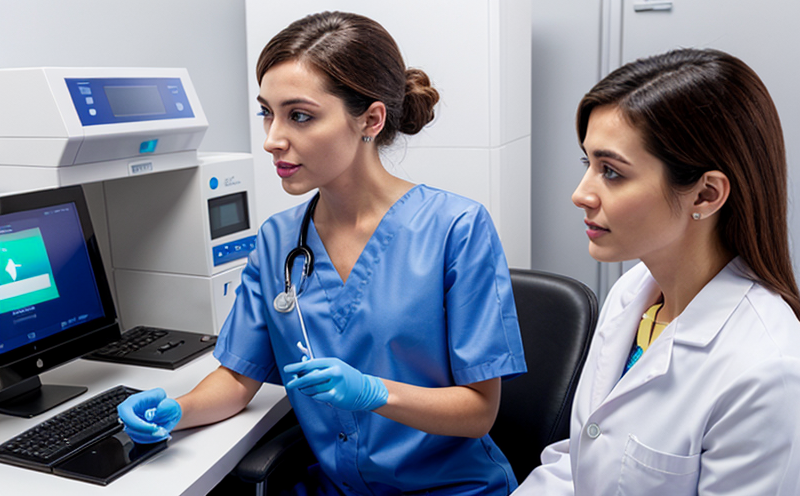PCR Detection of Borrelia burgdorferi in Tick Vectors
The PCR (Polymerase Chain Reaction) detection of Borrelia burgdorferi, the bacterium responsible for Lyme disease, within tick vectors is a critical diagnostic tool. This test is essential for identifying the presence and prevalence of this pathogen in ticks, thereby aiding public health officials to monitor and manage the spread of Lyme disease effectively.
Lyme disease, caused by Borrelia burgdorferi, has become an increasingly significant health concern globally. The bacterium is primarily transmitted through the bite of infected blacklegged ticks (Ixodes scapularis in North America and Ixodes ricinus in Europe). Early detection of the pathogen within tick populations allows for targeted interventions, such as treating affected areas with antibiotics or implementing public awareness campaigns.
The PCR test uses a highly sensitive method to amplify specific DNA sequences from Borrelia burgdorferi. This technique is capable of detecting even minute quantities of the pathogen in tick samples. The process involves extracting genomic material from ticks, followed by a series of amplification cycles that exponentially increase the target DNA segments. The amplified DNA can then be analyzed to confirm its identity and concentration.
The PCR test is preferred over other diagnostic methods for several reasons:
- High sensitivity and specificity: Ensures accurate detection with minimal false positives.
- Fast results: Provides quick identification of the pathogen, crucial during outbreaks or monitoring campaigns.
- Cost-effectiveness in large-scale surveillance programs.
In a typical clinical laboratory setting, the PCR test is performed using specialized equipment and reagents. The process begins with collecting tick samples from various geographic locations where Lyme disease has been reported. These ticks are then processed to extract their DNA, which is subjected to the PCR procedure. The amplified products can be further analyzed through gel electrophoresis or real-time qPCR methods for confirmation.
The use of PCR technology in tick vector testing contributes significantly to public health by providing a reliable means to track the spread of Lyme disease. This information helps healthcare professionals and policymakers make informed decisions about prevention strategies, treatment protocols, and resource allocation. By leveraging advanced molecular biology techniques like PCR, laboratories can provide valuable insights into infectious disease ecology, contributing to better health outcomes for affected populations.
Scope and Methodology
| Aspect | Description |
|---|---|
| Sample Collection | Ticks are collected from various geographic locations, including areas with known Lyme disease incidence. |
| Preparation | DNA extraction is performed using commercial kits or manual methods to obtain high-quality genomic material. |
| PCR Amplification | The extracted DNA undergoes multiple cycles of denaturation, annealing, and elongation to amplify the target Borrelia burgdorferi sequences. |
| Detection | The amplified products are analyzed through gel electrophoresis or real-time qPCR for confirmation of the pathogen's presence. |
| Methodological Considerations | Description |
|---|---|
| Quality Control | Incorporating positive and negative controls to ensure accurate amplification and interpretation. |
| Standardization | Adherence to international standards such as ISO 15189 for laboratory quality management systems. |
| Instrumentation | The use of advanced PCR machines like the ABI 7300 or Cepheid Xpert systems ensures precise amplification and detection. |
| Data Interpretation | An experienced laboratory team interprets results, ensuring accurate reporting and timely communication to relevant stakeholders. |
Why Choose This Test
The PCR detection of Borrelia burgdorferi in tick vectors offers several advantages over traditional diagnostic methods. Firstly, it provides a more accurate and sensitive means to identify the pathogen, reducing the risk of false negatives that can occur with less sophisticated techniques. Secondly, this test allows for rapid processing of samples, which is critical during outbreaks or when monitoring large geographic areas.
Another significant benefit is its cost-effectiveness in large-scale surveillance programs. By focusing on tick populations, resources are allocated efficiently to high-risk areas, ensuring that preventive measures are implemented where they are most needed. Additionally, the PCR test helps healthcare professionals and policymakers make informed decisions about treatment protocols and resource allocation.
The ability to track the spread of Lyme disease through tick vectors is crucial for public health officials. The PCR test provides a reliable method to monitor the prevalence of Borrelia burgdorferi in various regions, allowing for targeted interventions such as treating affected areas with antibiotics or implementing educational campaigns.
In conclusion, the PCR detection of Borrelia burgdorferi in tick vectors is a vital tool for public health professionals. It offers high sensitivity and specificity, rapid results, cost-effectiveness, and reliable data that can inform critical decisions about disease management and prevention strategies.
Competitive Advantage and Market Impact
The PCR detection of Borrelia burgdorferi in tick vectors offers several competitive advantages within the clinical and healthcare testing sector. Its high sensitivity and specificity make it an essential tool for accurate diagnostics, which is particularly important in regions with high Lyme disease incidence. The rapid processing time allows for timely interventions during outbreaks or large-scale surveillance programs.
The cost-effectiveness of this test is another key advantage, especially when dealing with large geographic areas. By focusing on tick populations, resources are allocated efficiently to high-risk zones, ensuring that preventive measures are implemented where they are most needed. This targeted approach not only enhances the effectiveness of interventions but also reduces unnecessary expenses.
The PCR detection method contributes significantly to public health by providing reliable data on the prevalence of Borrelia burgdorferi. This information helps healthcare professionals and policymakers make informed decisions about treatment protocols and resource allocation. The use of advanced molecular biology techniques like PCR ensures accurate reporting, which is crucial for effective disease management.
Moreover, the reliability and accuracy of this test have a broader market impact by fostering trust in diagnostic testing methods. It sets a benchmark for quality assurance in public health laboratories, ensuring that similar tests across different regions adhere to high standards of precision and reliability.





